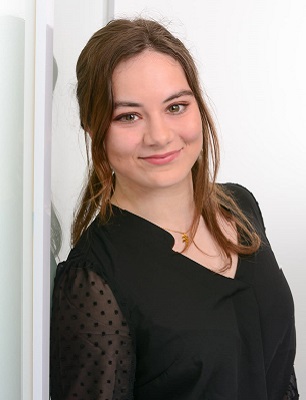Study on the Automated Assessment of Voice, Speech, and Associated Motor Function
 |
Maureen PetersilkaProject duration: Februar 2024 - August 2024The project was supported by the program for promotion of excellent women in science by the Faculty of Engineering / Christian-Albrechts-Universität zu Kiel. |
|---|
Introduction
Supported by a gender equality grant designated for female graduates with excellent performance in a STEM-related bachelor’s degree, Maureen Petersilka worked as a research assistant in the field of medical speech and tremor analysis at Kiel University. She contributed to projects led by PhD students Karolin Krüger (medical speech analysis) and Patricia Weede (tremor analysis) in the Department of Electrical Engineering.
The project focuses on the combination of tremor and speech analysis to investigate the relationship between objective speech parameters and clinical assessments, enabling further insights into the evaluation of speech and voice disorders. As part of a clinical study at UKSH Kiel, patients with Parkinson’s disease and essential tremor are examined to analyse speech characteristics and their correlation with motor impairments.
Before launching the study at UKSH Kiel, test phases were conducted at the Technical Faculty of Kiel University to ensure the system's performance under controlled conditions. With the first patients already examined, the study is now actively ongoing at UKSH Kiel.
Details
 For this study, a portable diagnostic system was designed, consisting mainly of:
For this study, a portable diagnostic system was designed, consisting mainly of:
- A tablet-based application (KIRAT) for video and recording
- A microphone for speech recordings
- EMG and motion sensors (DELSYS system) for tremor measurements
The speech analysis plays a central role in this study and consists of three main tasks:
- Vowel phonation
- Articulation
- Free Speech
Furthermore, the study incorporates a self-assessment component based on the Voice Handicap Index (VHI), providing subjective insights into speech-related difficulties. These insights can be compared with objectively derived parameters obtained through conventional signal processing methods, enabling a comprehensive assessment of speech impairments in neurological disorders.
 For tremor testing, patients perform different seated postures while EMG and motion sensors are attached to the extensor and flexor muscles of the forearm and the back of the hand (Fig. 2: Visualization of signals). Furthermore, during some tests, patients simultaneously perform a speech task to identify potential correlations between motor impairments and speech characteristics. The tremor characteristics are primarily evaluated using machine learning approaches, aiming to enhance the classification of Parkinson’s Disease and Essential Tremor.
For tremor testing, patients perform different seated postures while EMG and motion sensors are attached to the extensor and flexor muscles of the forearm and the back of the hand (Fig. 2: Visualization of signals). Furthermore, during some tests, patients simultaneously perform a speech task to identify potential correlations between motor impairments and speech characteristics. The tremor characteristics are primarily evaluated using machine learning approaches, aiming to enhance the classification of Parkinson’s Disease and Essential Tremor.
Outlook
The study will continue until a total of 100 patients have been examined. Once data collection is complete, the recorded speech and tremor data will be analysed separately as well as in correlation to each other to gain deeper insights into speech and motor impairments in neurological diseases.

 On behalf of the members of the Chair of Digital Signal Processing and System Theory, we would like to take this opportunity to wish you all a very Merry Christmas and a peaceful, restful winter break. We hope that this festive season brings you joy, relaxation, and cherished moments with your loved ones.
On behalf of the members of the Chair of Digital Signal Processing and System Theory, we would like to take this opportunity to wish you all a very Merry Christmas and a peaceful, restful winter break. We hope that this festive season brings you joy, relaxation, and cherished moments with your loved ones.